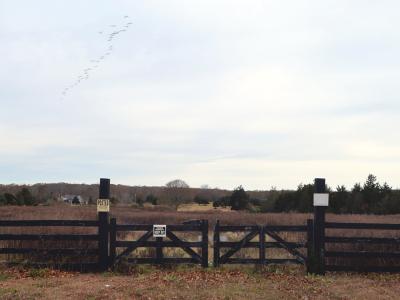Planners Review Affordable Housing

A longstanding East Hampton Housing Authority plan for affordable housing on a vacant 4.6-acre site on the north side of Montauk Highway in Amagansett underwent preliminary review by the East Hampton Town Planning Board on Nov. 15. The property stretches from a long-shuttered restaurant just east of the Amagansett I.G.A. to the Shell V&V gas station and backs up to the Long Island Rail Road tracks.
The plan calls for 38 apartments in seven one-story and three two-story buildings, a mixed-use building with four commercial spaces, each having an accessory studio apartment, an 1,872-square-foot, single-story common building, and a sewage treatment facility.
Each of the one-story buildings would contain one one-bedroom and one two-bedroom apartments. One two-story building is designed for four three-bedroom apartments, while another would contain four one-bedroom and four two-bedroom apartments.
Katherine Casey, the authority’s director, described the financial structure, telling the board the project would be self-sustaining. “There is no ongoing subsidy,” she said. Although some of the tenants would be subsidized under federal Section 8 guidelines, there would be no grants from the town, county, state, or federal government. “Rent revenues carry the project,” she said
Ms. Casey described a tiered rent system. A one-bedroom would start at $1,425 a month, a two-bedroom at $1,630, and three bedrooms from $2,300 or $2,400. Among other details, she said, the studio apartments would house employees of the businesses, and tenants would be expected to be year-round residents. Every year, rents would be based on residents’ income so that no one would be displaced.
Nancy Keeshan, a board member, asked if the tenants would be restricted to those from East Hampton. Ms. Casey responded that those who live or work in town would get preference, but that someone from a nearby area, say Southampton, could apply.
Tony Musso, the project’s architect, also attended the meeting, describing solar panels dispersed across the grounds, a community garden, and a playground.
One of the hurdles the authority faces is a town code prohibition on more than one use on given piece of property. According to JoAnne Pahwul, the assistant planning director, the site is one of two unusual parcels that are in an affordable housing overlay district as well as a limited business overlay district. In 2016, the town board discussed revising the code to allow a property in both overlay districts to contain both uses, she told the board, although it did not act.
The first member of the public to speak was James McMillan, an Amagansetter who questioned the need for businesses on the property at all. He pointed to several business buildings across the highway and noted that some have vacant spaces. Board members echoed that sentiment.
“My initial take is to get rid of the mixed-business use,” Randy Parsons, a board member, said. Another member, Ian Calder-Piedmonte, said, “From a planning prospective, I don’t understand it.”
Board members also were unsatisfied by the extent to which the development cuts into open space, and asked whether the single and two-story structures could be combined. Patti Leber asked if a three-dimensional model could be created so the board could better understand the proposal and its visual impact. Others who spoke were concerned about the number of students the project would add to the Amagansett School. An alarm about this had been heard when the proposal was first approached.
“My children are in Amagansett School. I love Amagansett. I want to keep the character of Amagansett. I understand affordable housing. Amagansett is a small town. For such a small town, it is a very big project,” Randi Ball said, estimating that the project would add about 40 children to the school.
“With this project, you’re dumping everything into Amagansett,” another resident, Michael Jordan, said. He also asked where the workers who service the septic system would come from.
“Everybody loves affordable housing, except when it is in their area,” Mr. Calder-Piedmonte said.
Bonnie Krupinski, a member of the Bistrian family, which owns 35 acres on the other side of the tracks to the north, said that if the proposed property were rezoned to allow two uses on the site, her family’s acreage should also be included. It would otherwise be a case of spot zoning, she said, threatening legal action.
Job Potter, the board chairman, expressed overall support, as did the other members, while Kathleen Cunningham and Diana Weir called for a traffic study to assess the effect on the highway of cars going in and out of the 88 parking spaces proposed.
